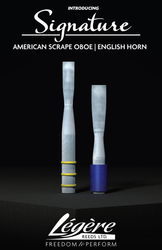Légère Synthetic American-Scrape Oboe & English Horn Reeds: A Review
Posted by Ann Hodge on Jul 23rd 2025
Légère is known for introducing the first “good” synthetic oboe reed when they launched their European-style oboe reed back in the summer of 2016. Three years later they unveiled a prototype of an American style synthetic reed at the IDRS Conference in Tampa, Florida. However, due to production difficulties, they had challenges maintaining the consistency and quality of the reed on a production scale. Now, after many years of waiting, they are finally here!
As someone who's been following Légère’s progress on this project, I was eager to put them through a proper test. Our inventory manager, Evan Tegley, DMA, also tested the new Légère reeds and had a very similar experience to mine.
What I Tested
I opened a selection to try: five medium soft reeds, five medium reeds, and one medium hard reed. After playing through one of each strength initially, I decided our shop would only stock the medium soft and medium varieties. The medium hard reeds simply required too much air and embouchure control, making them less appealing for most players looking for a synthetic alternative.
I also tested five medium and five medium hard English horn reeds
The Medium Soft Reeds
The medium soft reeds produced a notably dark tone that remained consistent across all five reeds I tried. This consistency is something you rarely get with cane reeds, even from the same batch. Articulation was clean and easy, and all maintained their medium-soft resistance as expected.
The tip openings tend toward the closed side without being restrictive. The notable issue here was intonation—these reeds consistently played flat to varying degrees with occasional instability on certain notes, particularly C5. This might behave differently on other oboe brands, but it's worth noting. I'm currently playing a Marigaux after switching from my Lorée.
The Medium Reeds
These reeds offer a fuller tone that can edge toward strident at times, though it is manageable. Like the medium soft reeds, articulation was reliable and the resistance stayed consistently medium across all samples. The tip openings were appropriately medium as well.
Like the MS reeds, the medium reeds were also fairly consistently flat to varying degrees. On the positive side, they didn't exhibit the saggy notes I noticed with the medium soft reeds.
The only reed that was perfectly in tune, was the sample reed that was tried by dozens of people at the IDRS conference. It may be that with some playing the pitch comes up, but I haven’t played on the new reeds enough to know. I will update this review after using the reeds over time.
The English Horn Reeds
The English horn reeds have a nice, warm tone. However, they had some upper register issues when tested on my Howarth and on Evan Tegley’s Marigaux. They tended to be flat and the upper register seemed unfocused.
Requiring more breathe support, the medium hard reeds otherwise mirrored the medium.
Of note, they were loose enough on the Ross bocal that it leaked. It just felt loose on the Hiniker bocals, but they did not leak. They fit perfectly on the Dallas, Marigaux, and Symer bocals.
My Take
These are solid synthetic reeds that serve their intended purpose well. The tone quality, articulation and hardness were incredibly consistent. I plan to use one regularly for practice sessions. The main advantage is predictability—you know what you're getting every time, which is valuable for any oboist who's dealt with the frustration of inconsistent cane reeds.
For oboists who find reed making challenging or simply don't have time to maintain a steady supply of good cane reeds this makes an excellent alternative for practicing. If the pitch comes up after a longer amount of playing, the Légère American series offers a viable alternative that's suitable for performance use as well.

